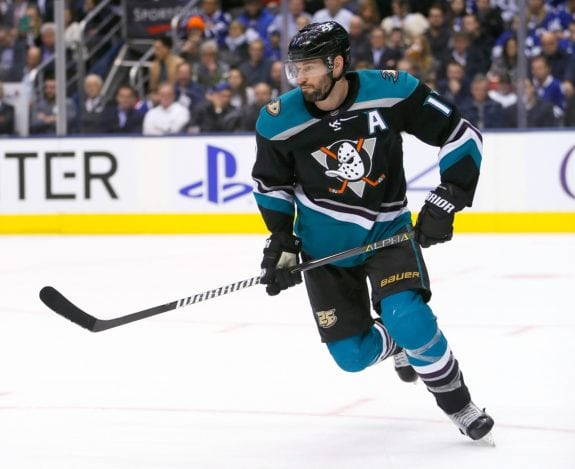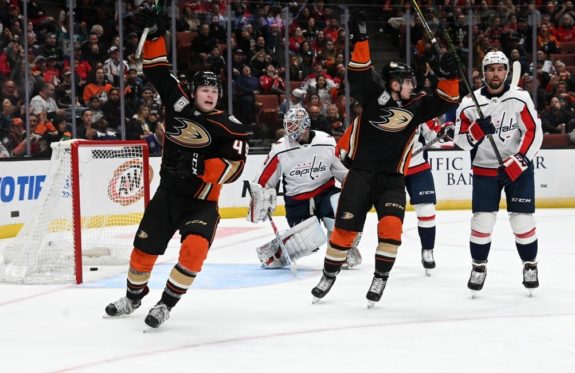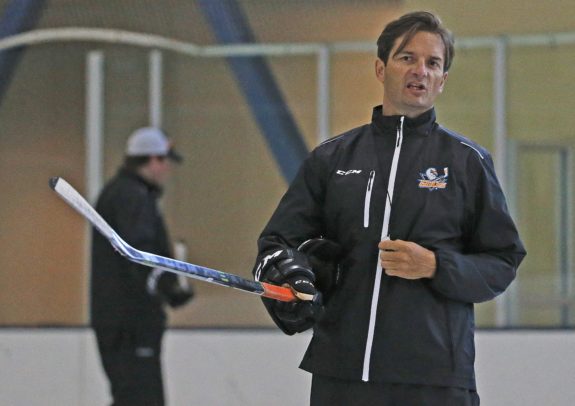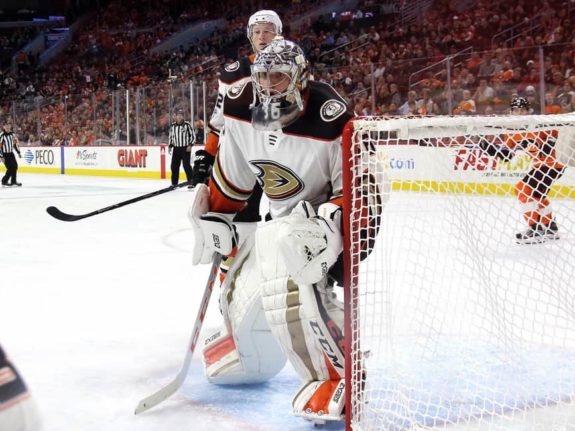It’s just over a week until the NHL drops the puck on the 2019-20 season and the Anaheim Ducks are hoping to move forward from one of their most disappointing seasons in recent memory. With an infusion of young talent coming and one of the best young goaltenders in the league, it’s hard to imagine the Ducks finishing lower in the standings this season than last. Here’s a look at the best- and worst-case scenarios for the 2019-20 Ducks.
Who’s In?
- Nick Deslauriers
- Chris Wideman
- Michael Del Zotto
- Andreas Martinson
- Jani Hakanpaa
- Andrew Poturalski
Of all of these players, most, except for Deslauriers, Del Zotto and Hakanpaa, will probably land in the AHL with the San Diego Gulls. Del Zotto and Hakanpaa are competing for a bottom pairing position on defense so it will likely be one or the other to make the Ducks, not both. Hakanpaa didn’t do himself any favors in the team’s first exhibition game, as you can see on the San Jose Sharks’ first goal.
As is tradition, none of these free agent signings or trade acquisitions move the needle much for Anaheim.
One of the two most intriguing players will be Deslauriers, who has around five-seasons of NHL experience, with a stop in the AHL for the Montreal Canadiens farm team, the Laval Rocket. Deslauriers’ career-high is 15 points with the Buffalo Sabres in 82 games in 2014-15, so the 28-year-old winger is probably a fourth-liner at best.
If Poturalski opens some eyes during training camp, he could be this season’s Ben Street or maybe even something better. The 25-year-old forward plays both center and wing and has spent the last three seasons lighting it up for the AHL’s Charlotte Checkers.
In the last three seasons, he’s posted 52, 49 and 70 points for the Checkers before general manager Bob Murray and the Ducks signed him as a free agent this offseason.
Perhaps the more important question is, who isn’t around?
Notable Absences
- Corey Perry
- Ryan Kesler
- Patrick Eaves
There are more players than just these three who will not be returning from last season’s squad, but the most notable are Perry, Kesler and Eaves. For obvious reasons, Perry is the most significant because along with Ryan Getzlaf he’s been a cornerstone of the franchise since he came into the league in 2005-06.
Unfortunately, Murray chose to buy out Perry in June; Perry then signed with the Dallas Stars before breaking his foot. You likely won’t be seeing him in a Ducks jersey until his No. 10 is retired.
Kesler and Eaves are still both part of the Ducks organization, but it’s questionable if either of them will ever suit up in another NHL game. Kesler had yet another hip surgery in May after barely breaking the 1,000 game barrier. Eaves squeaked out seven games and no points before illness and injury ended his 2018-19 season and stopped his 2019-20 season before it began.

Perry was injured most of last season and has been a shell of his former self since 2017-18. His spot at right wing has potentially opened up for Troy Terry.
Addition by Subtraction
As terrible as it is to write, compared to last season, all are addition by subtraction, two of them literally.
Eaves and Kesler are still under contract for Anaheim, but their long-term injuries mean they are eligible to go on long-term injured reserve and, according to CapFriendly they already are. That means their contracts can offer some salary-cap relief.
Cap relief isn’t that straightforward, and the customary reminder is that their contracts do not increase the salary cap, but rather allow the Ducks to exceed it by a certain amount.
The more significant point is that Kesler and Eaves are no longer taking up a roster spot and they provide some financial flexibility. For Kesler specifically, he won’t be laboring around the ice with a bum hip as a defensive liability and a total offensive black hole to reach 1,000 games.
The loss of all three players will be a net gain for the Ducks.
Ducks Offense Primed for Improvement
The best-case scenario isn’t truly the best-case scenario, as in winning the Stanley Cup, but for the Ducks, their best-case situation is sneaking into the postseason.
Dom Luszczyszyn of The Athletic and his complicated math formulas have the Ducks finishing at 88.5 points. Obviously, you can’t earn half points in hockey, but if you round up, that’s just a point out of the last playoff spot in 2018-19. (from ‘2019-20 NHL Season Preview: Anaheim Ducks’– The Athletic NHL – 9/7/19).
I don’t think that’s unrealistic. If the Ducks youngsters come to play this season, it won’t be hard for them to outdo their offensive numbers from 2018-19. Since 2013-14, the first full 82-game season after the 2012-13 lockout, the fewest goals scored by a playoff team has averaged 216. The Ducks scored 199 goals in one of their poorest offensive performances in franchise history.

Taking last season’s performance into account, the loss of Kesler, Eaves and Perry only subtracts 18 points from that total of 199. While it’s not an exact science, it’s not hard to envision a healthy Ondrej Kase, a resurgent Rickard Rakell and Getzlaf, and more experienced Terry, Sam Steel and Max Jones making up that difference in offense.
Add to that one of the league’s best goalies, and that means the most significant factor in the Ducks’ success is their defense.
Ducks Defense Has Something to Prove
While last season’s defensive performance was poor, the Ducks allowed fewer goals than the San Jose Sharks and the same amount of goals as the Toronto Maple Leafs at 251. Both the Sharks and Maple Leafs were playoff teams. While both those teams had potent offenses, which allowed for more porous defenses, the point is that the Ducks weren’t that far off.
The defense corps improving their performance is much easier said than done with all the gaps they have on their blueline, but they do still have veterans Hampus Lindholm, Josh Manson and Cam Fowler. It’s the bottom three defensemen that are unproven at best. Brendan Guhle, Jacob Larsson and Josh Mahura have only played a combined 99 games of NHL experience. Del Zotto won’t be the savior on the Ducks’ blue line just like he wasn’t last season.
The other issue is the unknown of Dallas Eakins and the defensive strategy he will employ with Anaheim. It’s no secret that his defensive scheme in Edmonton failed, but hopefully, he has learned from those mistakes.

If the best-case scenario plays out, the defense will have to make significant strides from last season, especially if Murray cannot acquire another right-shot defenseman like he has tried and failed to do with Justin Faulk and Rasmus Ristolainen.
The Western Conference Is Still a Gauntlet
The final factor is the conference and the division. Even with the losses of Jacob Trouba and potentially Dustin Byfuglien on defense, the Winnipeg Jets are still a formidable team, and the rest of the Central Division is still stacked. If you include the Chicago Blackhawks, who were within striking distance of the playoffs for most of the season, there are six teams in the Central with a realistic chance to make the playoffs. That means say goodbye to any wild-card spots for Pacific Division teams.
That leaves three spots available for the Ducks to qualify out of their own division. They won’t challenge the Vegas Golden Knights or the Calgary Flames. If everything comes together for the Ducks, they could catch the Sharks, who lost Joe Pavelski and Gustav Nyquist and re-signed a now 40-year-old Joe Thornton.
Ducks’ Worst-Case Scenario
Let’s face it, the team, on paper, isn’t as bad as they were last season. The Ducks might not be a playoff team, but they aren’t a bottom-eight team in the league like they were last season. Some of the older players have moved on, and younger players are starting to stake their claim on roster spots.
The worst-case scenario for this team is missing the playoffs but remaining in striking distance for most of the season. The odds that one of Steel, Comtois, Terry or Jones, has a breakout season is strong. If last season was rock bottom, a modest offensive and defensive improvement should keep them in the hunt longer.
The death blow to this team would be an injury to John Gibson. Things could’ve been much, much worse standings wise if Gibson hadn’t played out of his mind through mid-December of last season.

It would be tempting for Eakins, like it was for Randy Carlyle last season, to ride Gibson hard through the first part of the season to try to bank points. However, the history is clear; you need a rested starter to be successful late in the season.
Even if the Ducks Don’t Compete, They Can’t Exhaust Gibson
No starter on a Stanley Cup-winning team in the past six seasons played in more than 58 games during the regular season. Once again, the Ducks won’t be a Stanley Cup contending team this season, but resting a starting goalie is essential.
If the coaching staff is tempted to overplay Gibson at the beginning of the season, it might come back to bite them in the end, especially if they are on the cusp of the playoffs.
Over the long term, Gibson’s ability makes him a resource that needs to be conserved. Helping spread the workload with Ryan Miller, especially if the Ducks fall out of contention early, could help lengthen Gibson’s career.
Miller is one of the more capable backups in the league, but he’s up there in age and suffered an injury last season as well. An injury to Gibson could throw the Ducks into a season like last year or worse. If he remains healthy, the Ducks are, at worst, a team that will challenge for a playoff spot and fade by the end of the season.
This time of year, the future is always bright. In the preseason, fans hold out hope that even if their team isn’t supposed to light the world on fire, they might surprise people, much like the Golden Knights did two seasons ago and the New York Islanders did last season. Though Ducks fans shouldn’t expect a deep playoff run, if the team makes the playoffs at all, they should be excited for what the future holds, even if that future might be another season away.
All stats from hockey-reference.com